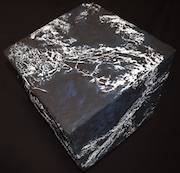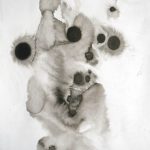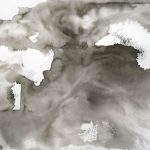Here’s an email interview with Nikos Rodousakis in early 2022 for Lung Fanzine in Greece.
• In 2007 you created a score for a film created by visual artist Daniel Colvin, under the title Atlas Dei. In 2007 you also released the album Illumination, a companion soundtrack of a multimedia installation by Michael Somoroff. Furthermore, the cover image of your album Stalker (with Brian “Lustmord” Williams) is a photograph by landscape photographer Brad Cole. So, do you think that the visual art of others can be a supplementary part of your work and what are the criteria for such collaborations?
RR: I have always loved the interaction of different sensory stimuli, especially when the various media collaborate to make something larger. My long friendship with Brad Cole has been especially fruitful. His work has honored quite a few of my albums, and I have tried to help him in other ways, when I can. My criteria for such interpersonal collaborations are: friendship and trust; a shared respect for each other’s work; and a feeling that we each have something to contribute that can make the experience larger than the individual contributors. Many people contact me to suggest collaboration, and if the situation doesn’t meet those criteria, I might simply offer that they license one of my pieces for their work. If someone wants to do a full collaboration with me, they should start out slowly and earn my respect and trust, as friends.
As far as the idea of “multimedia” arts in general, I have a complex relationship. I do not personally enjoy sensory overload experiences, and some multimedia art can fill the sensory inputs with too much information to digest, and it becomes flat to me. My mind goes blank when the noise level goes up. The collaborators who attract me, in other media, are those who understand how to make slower experiences that are full of substance and emotion.
• Stalker was inspired by the 1979 Soviet film of the same name, directed by Andrei Tarkovsky. What is your relation to cinema? Do you want to name some artist or films that you appreciate or, let’s say, have a similarity with your view?
RR: My reference above to slower experiences might also explain what I love about Tarkovsky, and what I don’t like about most Hollywood cinema. But it’s not only the slow pace that attracts me – it’s a feeling that the film is expressing something worth watching. Tarkovsky is more than just sepia film and long panning camera shots – his dialog is full of poetry, and his concepts ask fundamental questions about love and spirituality, memory and humanity, the questions of existence.
I should probably explain that most movies are too strong for me – too intense, too noisy, too violent, too manipulative. I have very thin skin, and sometimes I think my neurons are all outside of my body, getting pounded by the world. Most action films, dramas, sci-fi, thrillers and such, just feel painful to me, they hurt my skin and make me feel ill. So I don’t go to see many films. I trust a few rare directors to have a vision such that I can enter into their world. Tarkovsky, Bergman, Fellini, to name some of the older ones. I adore Jacque Rivette’s “Celine et Julie Vont ou Bateau” and Jeunet’s “Amélie”. In fact Jeunet is one of those film makers whom I have come to trust. “City of Lost Children” is another beautiful film. I like Tim Burton and Terry Gilliam very much, although I don’t always trust them. However they have made some of my favorite films – Gilliam’s “Brazil”, “Baron Munchausen”, “Time Bandits” among others, or Burton’s “Nightmare Before Christmas”, or “Miss Peregrines School for Peculiar Children”. I loved “Arrival” and I enjoyed “Interstellar” and other slow style science fiction films – the ones that resemble “2001: A Space Odyssey” perhaps? I hate the science fiction comic book movies where villains blow up the universe and superheroes try to save it. I respect the intensity and the style of David Cronenberg, and I enjoyed “Naked Lunch”, but I feel raped by many of his films. I don’t trust him. Similarly, David Lynch is another example of a director whom I like but I have trouble watching. I feel a kinship with his visual aesthetic, but I do not want to spend 90 minutes in the worlds he creates. I suppose the same would be true recently with Guillermo Del Toro. I love his vision, but I can’t handle the intensity. I need softer, slower environments for my sensory input.
• In 2001, you released an album titled Somnium, a 7-hour album divided into three tracks. This album was a recreation of the sleep concert environment you created during the 1980s at Stanford. Do you believe that the Western musical compositions are restricted by the fact that music is a commodity and, hence, must be supplied in a specific format?
RR: I think your question assumes the opposite of what I feel about the sleep concerts. These are the opposite of a commodity, they are intended as a social ritual, a gathering of dreaming. The problem comes from the fact that I cannot play sleep concerts for more than 50-100 people at a time, and the process of playing all night is exhausting. I get sick after playing sleep concerts. Most of my sleep concerts have been free to the public, and I have often performed them live on the radio or on the internet, broadcasting for free to anyone who wanted to listen. You can still listen to Somnium for free on YouTube, all 7 hours without pause.
However, I need to make a living with what I do, and I cannot survive on public rituals performed for free. When more people asked me for a way to experience the sleep concerts, I could not travel around the world playing for free all night to a few people at a time. In the 1990s the Internet did not offer a way to stream audio. Music still came on physical objects. DVD was a new format in the late 1990s and I tried to fit 8 hours of high resolution audio onto one disc, only to learn that DVD was better suited to video than audio, and it does not allow file sizes larger than 2 Gigabytes. I had to break up the audio into sections even though I mixed the piece as one continuous 7 hour flow. The format is secondary, but we need to be able to reach a listener with the music, so the format becomes a limiting step.
In a perfect world, music is not a commodity but something people make together, in a community for the joy of making. But we do not live in that world. Music has become a tool for selling sugar water, cars and tennis shoes. I hope that certain kinds of music can show people a deeper range of human experience, or take them to places in their imagination that show them how creative their own minds really can be.
• In your work someone can detect elements from John Cage, Terry Riley, Charlemagne Palestine, Eno, Cluster, Klaus Schulze, SPK and Throbbing Gristle. Can you refer to five important, Western or non-Western, music works?
RR: Several of those names you mentioned were big influences – especially Terry Riley and Cluster. I always respected Brian Eno’s skill at interpreting various avant guard and philosophical streams for the popular audience. Throbbing Gristle inspired me to see music as a form of psychic energy; likewise their DIY methods of creating and publishing their own cultural universe without the approval of any established media. I loved Klaus Schulze for the trance qualities in his music; but I lost interest due to the similarity from album to album: from Klaus I learned to try different approaches whenever I can, so I don’t get bored with myself. To name five important albums for my influences… always a question of my mood because there are many more than five. Here are 10: Terry Riley – Shri Camel; Sun Ra – The Magic City; Julian Priester – Pepo Mtoto Love Love; Wind Harp Song From the Hill; Langendriyan: Music Of Mangkunegaran Solo II (Javanese Gamelan); Jon Hassell – Aka/Darbari/Java Magic Realism; Cluster – Soweisoso; Popol Vuh – Tantric Songs; Jan Steele & John Cage – Voices and Instruments; Robert Wyatt – Rock Bottom.
Hopefully that will confuse people thoroughly!
• What was the need behind the Soundscape Productions? Which is your opinion about the current music industry?
RR: I created my label “Soundscape Productions” so I could release my own music starting in 1982. I believed in the idea of creating my own business and finding my own audience. This was a time growing from punk underground concepts of DIY; only I wasn’t coming from a place of anger and rebellion, but from a range of interests that simply did not have commercial “mass market” appeal. I felt it was better to reach one person with honesty than to reach a million people with commercialized fictions. I wanted to create a career that allowed me to follow my own truthful inquisitive path. The word “Soundscape” of course came from the book “Soundscapes” by R. Murray Schafer, which described the importance of our natural sonic environment and sent a warning about the noise of human culture.
• Do you get upset when you see your name under the NEW AGE label and not as a composer?
RR: It has been a 40 year-old problem, and it is pointless to stay angry about names for that long. I don’t care much about it anymore. I don’t know what to call my music, either. People get far too obsessed about categories. It’s just music. Of course I prefer other words, like “deep listening” “space music” “ambient” or whatever, but none of it matters.
• What leads you to express yourself through painting and graphic art? (https://robertrich.com/graphic-art/)
RR: I have always enjoyed painting. I started painting and drawing as a child, long before I considered myself a musician. Sometimes I go back to visual art to refresh my brain. My return to painting a few years ago was motivated by the decreasing physicality of music releases. When music came out on a “thing” like a record or CD, I could think about creating a full multisensory experience, with text and images to help tell the story alongside the music. Now that most people just listen to music on streaming services, I feel a bit empty when I release a new album. I don’t feel the same sense of satisfaction from streaming-only releases. They don’t feel real to me. So, the painting helps me satisfy my need to make things with my hands. I enjoy physicality.
• Based on your experience with the JI Calc, I wonder which is nowadays your relationship with the new technologies?
RR: JI Calc went beyond my skill level, and I needed to ask for help from people who were much better than me at programming. (Carter Scholz became the real author of that program.) I just wanted to make a tool that would help me tune my synthesizers, and help me to understand what chords sounded best in different just intonation tunings. I gave that software away to the very small community who could use it (I charged $10 to cover the cost of copying the floppy disk and putting it in the mail; so I didn’t give it away, exactly.)
I am not afraid of new technology. I embrace most new technologies; but I look at each development in terms of how it serves my needs and interests, or the needs of humanity in general. Unfortunately we are in a time when new technologies have emerged that offer mind-numbing distractions to people who become addicted to them. Online interactive gaming and social networking sites like Facebook or Instagram have sucked up the creative potential of a large portion of younger people, and I find myself at a higher level of distraction than I have ever experienced. Either the human mind will evolve to overcome this distracting cognitive burden, or the companies that drive the noise (and use our personal information) for their own immense wealth will take over our society. In the meantime, I hope that a few people can separate from the noise and return to earth, perhaps to help save the fragile ground that feeds us.
• You have studied at Stanford University and you have a lot of academic collaborations. Do you believe that academia changes your artistic perspective? Based on this, which is your advice to the young people who believe that academia kills inspiration and art?
RR: A good education can give people tools to stay curious and creative throughout their lives. For me, both science and art offer ways to ask questions, ways to engage with the world, ways to understand why we are here and how we can live more deeply. Asking questions gives meaning to existence. Sensuality, spirituality and emotion can coexist beautifully with intellect, inquiry and wonder. For me, this is the way I prefer to live. My music grows out of curiosity. My music investigates ideas, and it attempts to impart a sense of wonder and epiphany while exploring different corners of our comprehension of the universe. Far from killing inspiration and art, I think that a lifetime of curiosity is essential to remain creative, and I value my education for teaching me the skills to continue learning throughout life – not just while in school.
• By the way, is it easy to describe Robert Rich as a political subject? Is there an ideology or a movement that manages even for a will to adapt to your will?
RR: I try to avoid the politics of the moment, of political parties or of specific personalities. However, I worry deeply about the environmental impact of the human species upon our planet, and I admit that most of my political ideologies are less humanistic and more about the environment; however, we cannot begin to reverse the destruction of our planet unless we address the roots of social injustice and redirect the growing power of what I call “ultra-capitalism,” which refers to the ways that global corporations and monetary systems have more power than governments or societies, and can undermine the attempts of nations or communities to shift away from this pattern of destruction.
• When you were younger you began growing succulent plants. This is amazing. Ηow did you start such a hobby? Would you like to describe the experience?
RR: I have always loved living things in all variety. I especially love those forms of life that show the creativity of nature, the surprise that our world offers us when we look closely. Somehow, the curved and sculpted forms of succulents captured my imagination, with their thick leaves and alien surrealist shapes. They inspire my imagination. Similar attractions have pulled me toward other alien lifeforms on our planet like fungi and slime mold. I think we are living in such a diverse and complex planet that we need to understand what’s under our own feet if we will ever understand what we might find on other planets, if we get a chance to explore them.
• One of your other interests is food. You run a site of food-related topics and of course you have a long list of recipes for wild mushrooms (http://www.rrich.com/msframeset.html). I also love cooking and weird recipes. However, do you think that the best way to cook good quality mushrooms is directly on the fire?
RR: It’s true, I love to cook, and I love collecting wild mushrooms. I should move that old website to a modern web design. Those pages are using 1996-era HTML. First of all, I feel that mushrooms should always be cooked (unless being consumed for psychoactive purposes, I suppose.) The method of cooking depends upon the dish, of course. With fresh wild mushrooms, the first task is to reduce the amount of moisture in the fungus without losing the flavor. In some species – like chanterelles in California for example – the liquid that comes from the mushroom is not always delicious, and should be discarded. In other species – like boletes – the liquid holds all the best flavor and should be reduced and concentrated. For these, the best method is to sautée in olive oil or butter, perhaps with some onion, garlic, salt and pepper, before adding to other ingredients. Grilling directly on the fire is a good method for some mushrooms, like the large Agaricus bisporus they call “portobello” here in the USA, but in general it only works for large fleshy mushrooms without much moisture. It all depends on the desired result!
Thank you! (Nikos Rodousakis for Lung fanzine)






You must be logged in to post a comment.